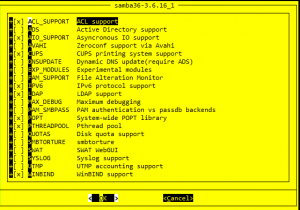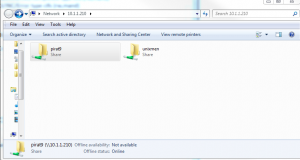I will not give a definition of Samba because every Unix/Linux Administrator should know about it. I will skip directly to show you an easy step-by-step how-to article to setup your FreeBSD Samba server.
My server
root@FreeBSD-unixmen:/root # uname -a FreeBSD FreeBSD-unixmen 9.1-RELEASE FreeBSD 9.1-RELEASE #0 r243826: Tue Dec 4 06:55:39 UTC 2012 root@obrian.cse.buffalo.edu:/usr/obj/usr/src/sys/GENERIC i386
Install Samba
You need to have ports installed. After you have it installed, you need to go to the Samba directory in ports by using this command:
root@FreeBSD-unixmen:/root # cd /usr/ports/net/samba36 root@FreeBSD-unixmen:/root # make install clean
You can add extra components to your Samba server. If you want like Webind and Swat.
Now edit /etc/rc.conf so that Samba will start with every system boot. Add this line to the file and save:
samba_enable="YES"
Configure Samba
Edit /usr/local/etc/smb.conf:
root@FreeBSD-unixmen:/root # vi /usr/local/etc/smb.conf
Specify where you will be able to connect:
; hosts allow = 192.168.1. 192.168.2. 127.
Remove the semi-colon and change the IP address so it matches your network. For example, in my case:
hosts allow = 192.168.1. 192.168.0. 127. 10.1.1.
Now configure the share in the same configuration file:
[unixmen] comment = Unixmen FreeBSD SAMBA path = /Unixmen valid users = pirat9 public = no writable = yes
Save and exit.
Adding Samba user
Use command adduser to add unix user. In my situation pirat9:
root@FreeBSD-unixmen:/root # adduser Username: pirat9 Full name: test1 test2 Uid (Leave empty for default): Login group [test]: Login group is test. Invite test into other groups? []: Login class [default]: Shell (sh csh tcsh bash rbash nologin) [sh]: Home directory [/home/test]: Home directory permissions (Leave empty for default): Use password-based authentication? [yes]: Use an empty password? (yes/no) [no]: Use a random password? (yes/no) [no]: Enter password: Enter password again: Lock out the account after creation? [no]: Username : pirat9 Password : ***** Full Name : test1 test2 Uid : 1002 Class : Groups : pirat9 Home : /home/pirat9 Home Mode : Shell : /bin/sh Locked : no OK? (yes/no): yes adduser: INFO: Successfully added (pirat9) to the user database. Add another user? (yes/no):
Add the directory you want to share for Samba:
root@FreeBSD-unixmen:/root # mkdir -p /Unixmen
Adding the Samba group and the user pirat9:
root@FreeBSD-unixmen:/root # pw groupadd smbprivate -M pirat9
Change permission on the Samba folder:
root@FreeBSD-unixmen:/root # chgrp smbprivate /Unixmen root@FreeBSD-unixmen:/root # chmod 770 /Unixmen
Now it’s time to set the password:
root@FreeBSD-unixmen:/root # smbpasswd -a pirat9 New SMB password: Retype new SMB password: Added user pirat9.
Start the Samba server:
root@FreeBSD-unixmen:/root # /usr/local/etc/rc.d/samba start Removing stale Samba tdb files: . done Starting nmbd. Starting smbd.
Testing the server
Run this command to test the server:
root@FreeBSD-unixmen:/root # smbclient -U pirat9 -L localhost Enter pirat9's password: Domain=[MYGROUP] OS=[Unix] Server=[Samba 3.6.9] Sharename Type Comment --------- ---- ------- unixmen Disk Unixmen FreeBSD SAMBA IPC$ IPC IPC Service (Samba Server) pirat9 Disk Home Directories Domain=[MYGROUP] OS=[Unix] Server=[Samba 3.6.9] Server Comment --------- ------- FREEBSD-UNIXMEN Samba Server Workgroup Master --------- ------- MYGROUP FREEBSD-UNIXMEN
Now try to connect from a Windows OS machine and login with the Samba credentials:
\\ip-to-your-freebsd-server
This is how it displays from Windows 7.







